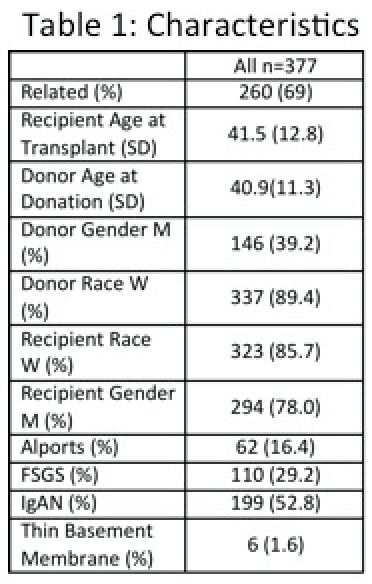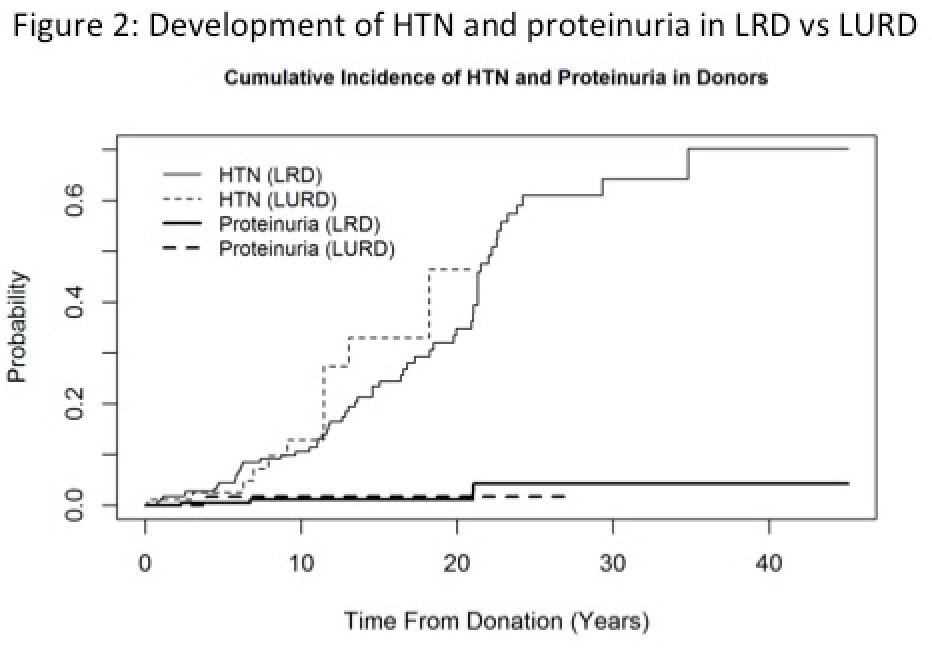GFR Outcomes for Recipients and Donors with IgA, FSGS, Alports and Thin Basement Membrane Disease: A Comparison of Living Related to Unrelated Donors
University of Minnesota, Minneapolis, MN
Meeting: 2019 American Transplant Congress
Abstract number: B128
Keywords: Donation, Glomerular filtration rate (GFR), Kidney transplantation, Renal function
Session Information
Session Name: Poster Session B: Kidney Donor Selection / Management Issues
Session Type: Poster Session
Date: Sunday, June 2, 2019
Session Time: 6:00pm-7:00pm
 Presentation Time: 6:00pm-7:00pm
Presentation Time: 6:00pm-7:00pm
Location: Hall C & D
*Purpose: Prior studies have shown an increase rate of graft loss in patients that receive living donor kidney transplants from relatives in IgA, FSGS, and other potentially genetic kidney diseases. Also, there is data that shows an increase risk of ESRD in donors that donate to a relative (Wainright, AJT, 2018). As such, we sought to compare the eGFR of both donors and recipients, of living related vs unrelated donors in recipients with IgA, FSGS, Alports and TBM disease.
*Methods: 377 living donor transplants with recipients with IgA, FSGS, Alports and TBM disease. Of these, 260 were related and 117 were unrelated. We then looked at eGFR of the donors and recipients post transplant/donation. The eGFR was determined by CKD-Epi Cr.
*Results: The characteristics of the donors are listed in Table 1. The eGFR pattern of living related vs unrelated donors after transplant is shown in Figure 1. There is no significant difference in change in GFR post donation in related vs unrelated donors. In addition, for related vs unrelated donors, there was no significant difference in the development of post donation hypertension or proteinuria (Figure 2). Finally, in recipients with ESRD due to IgA, FSGS, Alports, and TBM disease, there was no difference in post transplant eGFR comparing recipients of related vs unrelated live donors.
*Conclusions: For living donors, donating to recipients with ESRD due to IgA, FSGS, Alports and TBM disease, there was no difference in post donation eGFR between related vs unrelated donors or in the incidence of post donation hypertension or proteinuria. For the recipients, the trajectory of eGFR did not differ in related donors compared with unrelated donors.
To cite this abstract in AMA style:
Keys D, Jackson S, Riad S, Spong R, Vakil V, Matas A, Nachman P. GFR Outcomes for Recipients and Donors with IgA, FSGS, Alports and Thin Basement Membrane Disease: A Comparison of Living Related to Unrelated Donors [abstract]. Am J Transplant. 2019; 19 (suppl 3). https://atcmeetingabstracts.com/abstract/gfr-outcomes-for-recipients-and-donors-with-iga-fsgs-alports-and-thin-basement-membrane-disease-a-comparison-of-living-related-to-unrelated-donors/. Accessed December 28, 2025.« Back to 2019 American Transplant Congress



